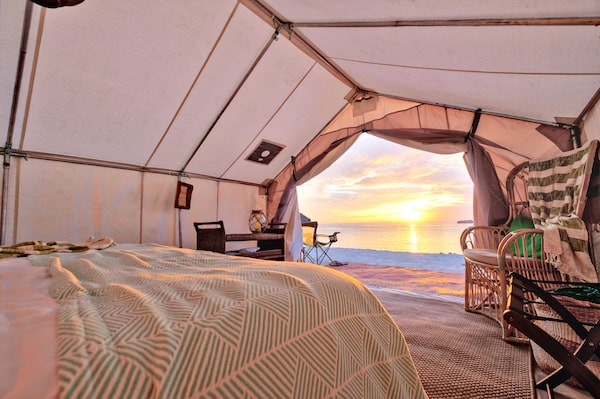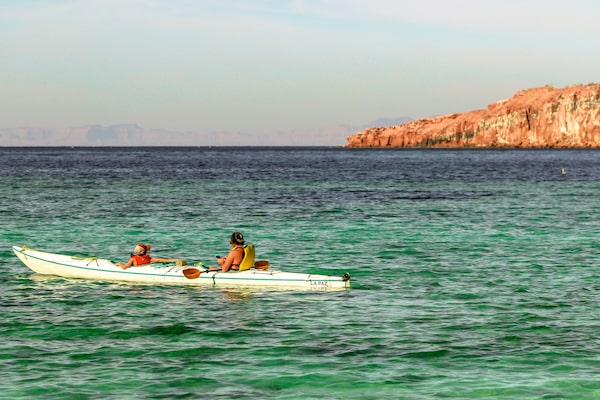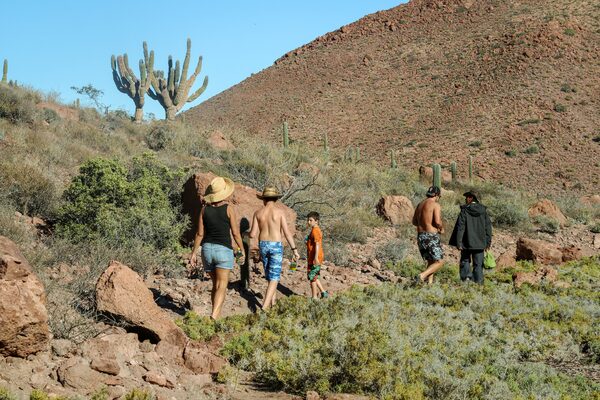
A tent at Camp Cecil in Isla Espiritu Santo.Keenan Shoal/Todos Santos Eco Adventures
There must have been at least 300 of them, sea lions in all sizes and colours – some glistening ebony, others silvery blue, still others almost ivory-hued. Some were perched on boulders sleeping soundly, others sunned themselves on their backs and sides. Babies crawled on top of bigger ones to find a good spot to snuggle, while adolescent pups bounded off the rocks to play in the water. The scene could be likened to a school playground gone mad, but instead of children shouting and squealing, the soundtrack was one of cacophonous barking.
We had come to this protected sea-lion colony in Baja California Sur by boat from our accommodations further down the coast of Isla Espiritu Santo. The small island in the Sea of Cortez, part of a UNESCO Biosphere Reserve and a World Heritage Site, lies an hour’s boat ride from the Mexican city of La Paz. One of the most biodiverse areas on the planet, its permanent and part-time non-human residents include black jackrabbits and antelope squirrels – two species endemic to the island – blue whales, humpback whales, dolphins, sea lions, whale sharks, manta rays, sea turtles, dolphins, blue-footed boobies, frigate birds and pelicans.
The island itself is stunning, with towering cliffs in surreal shapes; white sand bays; awe-inducing lava rock formations; and rock art left by the extinct Guaycura and Pericu Indians. I was staying at Camp Cecil, a sustainable glamping outfit that attracts eco-minded travellers and nature and wildlife lovers looking to get off the grid (no WiFi or cellphone service here). It’s an opportunity to experience outdoor adventure, animal encounters and total relaxation – without having to truly rough it.

Visitors of Isla Espiritu Santo are treated towering cliffs, white sand bays, awe-inducing lava rock formations and rock art left by the extinct Guaycura and Pericu Indian.Elizabeth Warkentin/The Globe and Mail
Of course, when it comes to nature, nothing is guaranteed. After tiring of trying to take decent photos of the seals from a rocking boat, I slipped into the water with the rest of my group, trying not to make a splash – we’d been warned against any surprise moves that could scare the animals. Ahead of me, a Mexican tourist was smiling and shouting happily to his friends: Increible! “Incredible!” I looked up just in time to see a pup, no more than two feet long, twirling his body around the man’s neck before retreating underwater. All around me, other visitors seemed to be having similar joyful experiences.
But too soon, our boat’s allotted 90 minutes at the colony was up, and still I hadn’t had my own personal encounter. As I swam back, feeling disheartened, I suddenly felt a weight land on the back of my neck. I screamed. I looked and felt behind me, but found nothing. Then I turned and looked down into the water, and there he was: The cheeky little rascal had disappeared, only to materialize a few feet before me and peer at me impishly with big black eyes – as if to say, “Got you, didn’t I?” And then he (or perhaps it was a she?) was off.
Arriving back at Camp Cecil an hour later, I was famished. (An adrenaline-filled morning with exuberant sea mammals will do that to you.) As usual, the meal at the boutique encampment was an event. Ivan, a young Italian chef who has worked in large hotel kitchens in Milan and California, and his Mexican assistant, Giovanni, produced a multitude of culinary delights in their solar-powered kitchen: fajitas, white-bean soup, quinoa salad, quesadillas, mango mousse. Every dish was more fresh, flavourful and enticing than the last, and they even prepared a special vegan ceviche for me and the two vegetarians on the trip.
Travellers looking to get off the grid can visit the camp, which has no WiFi or cellphone service.Greg Fisher/Todos Santos Eco Adventures
It’s all in keeping with the ethos of the camp, opened in 2016 by Bryan and Sergio Jauregui, owners of Todos Santos Eco Adventures. The married couple is proud of their home region here in southern Baja California, and work to show off the area to its best advantage while minimizing tourism’s footprint on the environment. Camp Cecil runs entirely on solar power, has eliminated single-use plastics and sources its seafood from two local fisherman who were given permission to stay after Espiritu Santo was declared part of a national marine park. “They’re 89 and 91 years old now,” said Hernando, one of our naturalist guides, “but they still fish every day.”
Conversation at mealtimes was easy and animated. During one meal, a guest recounted how she had woken the night before to an animal lying on her chest. Scared – and thinking it was a rat – she pushed the creature off. “No, no,” said our guides Hernando and Mauricio, both of whom did double duty as attentive hosts. “The animal who visited your tent was a babisuri,” Mauricio explained. “Babisuri are a ring-tailed cat subspecies. They’re found only on Espiritu Santo. Nowhere else.”
“We call him Poncho,” Hernando added.
Time on the island passed in a slow, natural rhythm, matching the gentle cadence of the lapping waves. Guests at Camp Cecil can be as adventurous or hedonistic as they wish. Between meals, you can laze on the beach in the sun, breathing in the heady scent of the salty sea and arid desert air. Or you can collect shells, look for little orange crabs on the rocks and, even in January when I visited, go for a swim. More active types opt to kayak to the frigate-bird colony, paddle a SUP to the next cove or explore the rock cave at the end of the beach. On my second afternoon, I went on a guided desert hike. Along the way to the lookout point, we spotted sun-bleached animal bones, likely those of a jackrabbit, giant agave and other desert plants. I was stunned to see cacti twice the height and three times the girth of a large man.
The sun sets early in Mexico in January, and as my companions and I sipped grapefruit margaritas at happy hour on our final evening, we gazed upon a classic Baja tableau: silhouettes of frigate birds soaring high in the tangerine sky above a purple sea, and the serrated forms of mountains along the distant coastline.
It had been a long day, and I retired early. Camp Cecil may be a sustainable outfit, but Bryan and Sergio haven’t held back on the accommodations. My tent, a large white-canvas affair, was furnished with sisal matting, a colourful rug, a wicker armchair, a solar fan and a hurricane lantern. The bed was a plush-top queen adorned with pillows and throws in shades of coral and peach. The bed was flanked on both sides by folding butler’s trays, each with its own glass candle-holder.

Married couple Bryan and Sergio Jauregui opened Camp Cecil in 2016, and work to show the southern Baka California region while minimizing tourism’s footprint on the environment.Elizabeth Warkentin/The Globe and Mail
That night, after picking my way back down the path from the compost toilet cabana, I gazed at the indigo sky – awash with brilliant crystal studs – and the whiteness of the tents, opalescent against the constellations above. I hoped I would fall back asleep quickly, wrapped in dreams of frolicking sea lions and mischievous ring-tailed cats.
Your Turn
You can fly direct to San Jose del Cabo (Los Cabos) from Toronto, Vancouver, Calgary or Edmonton. The car ride from the airport to Todos Santos, where Todos Santos Eco Adventures is based, takes about a hour and 15 minutes. Alternatively, drive to La Paz (a little over two hours), the capital of Baja California Sur, a charming little city in which to spend a few days before meeting guides for the boat trip to Isla Espiritu Santo.
Rates at Camp Cecil start at US$375 per person, based on double occupancy, minimum two-night stay required. That includes hotel pickup/drop-off in Todos Santos or La Paz, round-trip boat transfer to Camp Cecil, snorkelling gear and wetsuit, all meals from lunch on day one through breakfast on your final day, daily happy hour, all adventures, luxury tent accommodations and bilingual naturalist guide. All adventures, transfers and meals are on a shared basis unless special arrangements are made (tosea.net).
The writer was a guest of Todos Santos Eco Adventures. It did not review or approve this article.